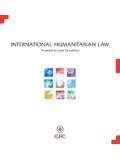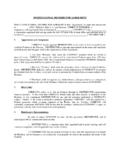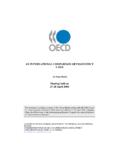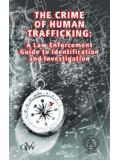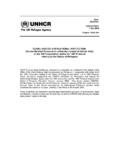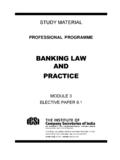Transcription of The employment relationship
1 international Labour Conference, 95th Session, 2006 Report V(1) The employment relationship Fifth item on the agenda international Labour Office Geneva ISBN 92-2-116611-2 ISSN 0074-6681 First published 2005 The designations employed in ILO publications, which are in conformity with United Nations practice, and the presentation of material therein do not imply the expression of any opinion whatsoever on the part of the international Labour Office concerning the legal status of any country, area or territory or of its authorities, or concerning the delimitation of its frontiers. Reference to names of firms and commercial products and processes does not imply their endorsement by the international Labour Office, and any failure to mention a particular firm, commercial product or process is not a sign of disapproval. ILO publications can be obtained through major booksellers or ILO local offices in many countries, or direct from ILO Publications, international Labour Office, CH-1211 Geneva 22, Switzerland.
2 Catalogues or lists of new publications are available free of charge from the above address, or by email: . Visit our web site: . Formatted by TTE: reference Confrep\ILC95(2006)\Report V(1)-2004-09-0068-1 Printed in Switzerland ATA iii Contents Page Introduction .. 1 Chapter I. The employment relationship : Overview of challenges and 3 Evolution of the discussion at the ILO on the employment relationship .. 4 The employment relationship and the law .. 6 The employment relationship and workers 8 Context of the lack of 8 Repercussions of the lack of 9 Uncertainty with regard to the law .. 11 Closing the gap .. 15 Clarifying the scope of the law .. 15 Adjusting the limits of the legislation .. 15 Balancing equity and 16 Ensuring 16 Chapter II. Trends and problems in regulation: A comparative 19 The law and the employment relationship .. 19 Substantive definitions.
3 20 Descriptive definitions .. 21 Parties to the employment relationship .. 22 Determining the existence of an employment 24 The principle of the primacy of 24 Determination by law .. 26 Easing the burden of 28 Clarifying the scope of the employment 30 Defining the scope of the employment 31 Delineating the boundary between dependent and independent 33 The combined 35 Categorizing certain types of work .. 37 Extending the scope of legislation to equivalent workers .. 38 Developments in case law .. 38 Regulation of triangular employment 42 Who is the employer (the provider)? .. 42 What is the position of the user? .. 45 What are the worker s rights? .. 47 Compliance and 50 The employment relationship iv Page Chapter III. A new instrument: The basis and possible content of a Recommendation .. 53 Structure of the 54 Content of the questionnaire.
4 54 Section I: Form of the international instrument .. 54 Section II: 54 Section III: Content of the instrument .. 55 Section IV: Other 58 59 Annex 1. Resolution concerning the possible adoption of international instruments for the protection of workers in the situations identified by the Committee on Contract 71 Annex 2. Resolution concerning the employment 72 Annex 3. employment by status in employment and sex, latest 78 Annex 4. List of referenced legislation .. 85 1 Introduction 1. The question of the employment relationship will be examined according to the single-discussion procedure established in article 38 of the Standing Orders of the Conference. The Office has accordingly produced the present summary report on law and practice, which covers a broad spectrum of existing law and practice in more than 60 ILO member States across different regions and different legal systems and traditions.
5 The report provides a comparative analysis of the main developments and emerging trends based on a review of the legal texts, case law and other forms of regulation. It is accompanied by a questionnaire drawn up with a view to the preparation of a Recommendation. Governments are invited to give detailed replies to the questionnaire, on the basis of which the Office will prepare a final report in accordance with article 38, paragraph 2, of the Standing Orders of the Conference. This final report will contain a draft Recommendation for consideration by the Conference. 2. In accordance with the provisions of article 38, paragraph 1, of the Standing Orders, the present report must reach governments not less than 18 months before the opening of the 95th Session of the Conference in 2006. In accordance with paragraph 2 of the same article, the final report must be communicated to governments not less than four months before the opening of the 95th Session of the Conference.
6 So that the Office has time to examine the replies to the questionnaire and prepare the final report, governments are requested to ensure that their replies to the questionnaire reach the international Labour Office in Geneva by 1 July 2005, or by 1 August 2005 in the case of federal countries and countries where it is necessary to translate the questionnaire into the national language. 3. The Office wishes to draw the attention of governments to article 38, paragraph 1, of the Standing Orders, which calls on them to consult the most representative organizations of employers and workers before they finalize their replies. The governments replies should reflect the results of these consultations and indicate the organizations consulted. 4. This report is divided into three chapters as follows. Chapter I traces the evolution over the last decade of the discussions at the ILO on the employment relationship , including the discussions on contract labour in 1997 and 1998, the 2000 Meeting of Experts on Workers in Situations Needing Protection and the 2003 general discussion.
7 It also summarizes the most pertinent issues identified by the 39 national studies conducted in 1999-2001. Chapter II provides an overview of trends and problems in regard to the manner in which the general aspects of the employment relationship are regulated in different countries. This is based on a comparative analysis of the relevant laws of more The employment relationship 2 than 60 ILO member States; it elaborates on and supplements the information on law and practice provided in the report submitted for general discussion to the 91st Session of the international Labour Conference in 2003. 1 Chapter III briefly introduces the rationale behind the questionnaire and outlines its structure and content. 1 ILO: The scope of the employment relationship , Report V, international Labour Conference, 91st Session, Geneva, 2003. 3 Chapter I The employment relationship : Overview of challenges and opportunities 5.
8 The employment relationship is a legal notion widely used in countries around the world to refer to the relationship between a person called an employee (frequently referred to as a worker ) and an employer for whom the employee performs work under certain conditions in return for remuneration. It is through the employment relationship , however defined, that reciprocal rights and obligations are created between the employee and the employer. The employment relationship has been, and continues to be, the main vehicle through which workers gain access to the rights and benefits associated with employment in the areas of labour law and social security. It is the key point of reference for determining the nature and extent of employers rights and obligations towards their workers. 6. The profound changes occurring in the world of work, and particularly in the labour market, have given rise to new forms of relationship which do not always fit within the parameters of the employment relationship .
9 While this has increased flexibility in the labour market, it has also led to a growing number of workers whose employment status is unclear and who are consequently outside the scope of the protection normally associated with an employment relationship . In 2004, the Director-General of the international Labour Office described the challenge as follows: The State has a key role to play in creating an enabling institutional framework to balance the need for flexibility for enterprises and security for workers in meeting the changing demands of a global economy .. At the heart of national policies to meet the social challenges of globalization is a dynamic strategy for managing labour market change. 1 7. The legal framework governing the employment relationship is an important component of national policy for managing labour market change taking account of the need for flexibility and security.
10 8. The question of the employment relationship has, in one form or another, been on the agenda of the international Labour Conference for over a decade. The following is an overview of the evolution of these discussions culminating in the general discussion in 2003. This chapter also summarizes the most pertinent issues raised in the national studies conducted in 1999-2001, which formed the basis of the report prepared by the Office for the 2003 general discussion and which are comprehensively analysed and referenced in that report. 2 1 ILO: A fair globalization: The role of the ILO, Report of the Director-General on the World Commission on the Social Dimension of Globalization, international Labour Conference, 92nd Session, Geneva, 2004, p. 17. 2 ILO: The scope of the employment relationship , Report V, international Labour Conference, 91st Session, Geneva, 2003.











